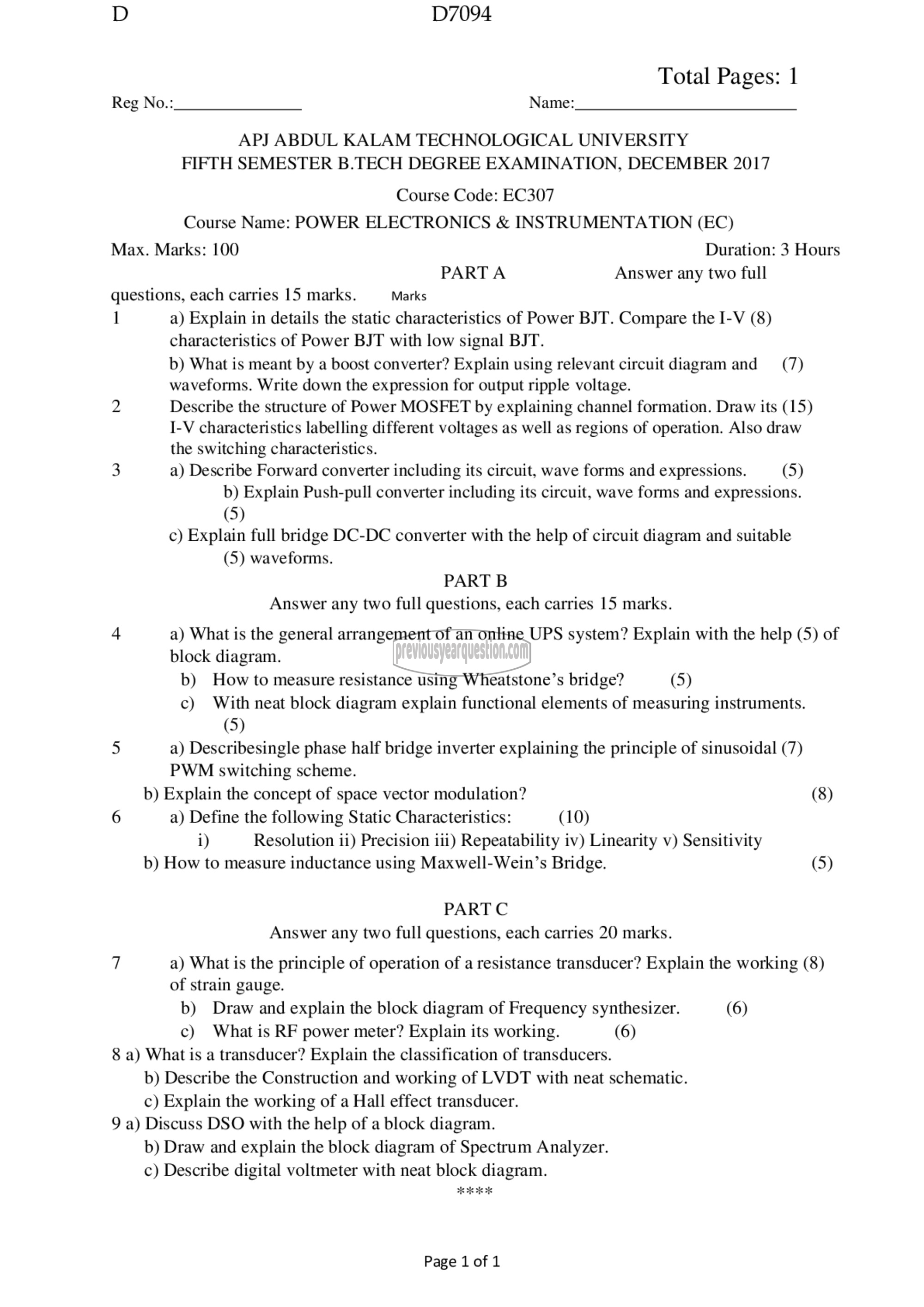APJ ABDUL KALAM TECHNOLOGICAL UNIVERSITY Previous Years Question Paper & Answer
Semester : SEMESTER 5
Subject : Power Electronics & Instrumentation
Year : 2017
Term : DECEMBER
Scheme : 2015 Full Time
Course Code : EC 307
Page:1
D D7094
Total Pages: 1
Reg No.: Name:
APJ ABDUL KALAM TECHNOLOGICAL UNIVERSITY
FIFTH SEMESTER B.TECH DEGREE EXAMINATION, DECEMBER 2017
Course Code: EC307
Course Name: POWER ELECTRONICS & INSTRUMENTATION (EC)
Max. Marks: 100 Duration: 3 Hours
PARTA Answer any two full
questions, each carries 15 marks. Marks
1 a) Explain in details the static characteristics of Power BJT. Compare the I-V (8)
characteristics of Power BJT with low signal BJT.
0) What is meant by a boost converter? Explain using relevant circuit diagram and (7)
waveforms. Write down the expression for output ripple voltage.
2 Describe the structure of Power MOSFET by explaining channel formation. Draw its (15)
I-V characteristics labelling different voltages as well as regions of operation. Also draw
the switching characteristics.
3 a) Describe Forward converter including its circuit, wave forms and expressions. (5)
b) Explain Push-pull converter including its circuit, wave forms and expressions.
(5)
0) Explain full bridge DC-DC converter with the help of circuit diagram and suitable
(5) waveforms.
PART 8
Answer any two full questions, each carries 15 marks.
4 a) What is the general arrangement of an online UPS system? Explain with the help (5) of
block diagram.
b) How to measure resistance using Wheatstone’s bridge? (5)
c) With neat block diagram explain functional elements of measuring instruments.
(5)
5 a) Describesingle phase half bridge inverter explaining the principle of sinusoidal (7)
PWM switching scheme.
b) Explain the concept of space vector modulation? (8)
6 a) Define the following Static Characteristics: (10)
i) Resolution ii) Precision iii) Repeatability iv) Linearity v) Sensitivity
b) How to measure inductance using Maxwell-Wein’s Bridge. (5)
PART C
Answer any two full questions, each carries 20 marks.
7 a) What is the principle of operation of a resistance transducer? Explain the working (8)
of strain gauge.
b) Draw and explain the block diagram of Frequency synthesizer. (6)
c) What is RF power meter? Explain its working. (6)
8 a) What is a transducer? Explain the classification of transducers.
b) Describe the Construction and working of LVDT with neat schematic.
c) Explain the working of a Hall effect transducer.
9 a) Discuss DSO with the help of a block diagram.
b) Draw and explain the block diagram of Spectrum Analyzer.
c) Describe digital voltmeter with neat block diagram.
بد بد oi
Page 1 of 1
